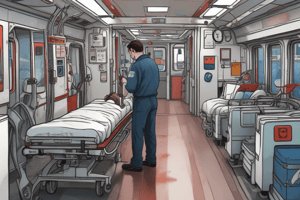Podcast
Questions and Answers
A properly sized blood pressure cuff should cover?
A properly sized blood pressure cuff should cover?
two thirds the length from the armpit to the crease at the elbow.
After performing a head tilt-chin lift maneuver to open the airway of an unresponsive patient who has a pulse, you should?
After performing a head tilt-chin lift maneuver to open the airway of an unresponsive patient who has a pulse, you should?
suction as needed and insert an airway adjunct.
When assessing the skin of an unresponsive patient, you note that it has a bluish tint to it. This finding is called?
When assessing the skin of an unresponsive patient, you note that it has a bluish tint to it. This finding is called?
cyanosis.
A 50-year-old male presents with altered mental status. After administering oxygen if needed, you should?
A 50-year-old male presents with altered mental status. After administering oxygen if needed, you should?
Normal respiratory rates should not exceed _______ breaths per minute in toddlers and _______ breaths per minute in infants.
Normal respiratory rates should not exceed _______ breaths per minute in toddlers and _______ breaths per minute in infants.
Which of the following signs of respiratory distress is usually observed only in pediatric patients?
Which of the following signs of respiratory distress is usually observed only in pediatric patients?
When approaching a 32-year-old male who is complaining of traumatic neck pain, you should?
When approaching a 32-year-old male who is complaining of traumatic neck pain, you should?
What part of the patient assessment process focuses on obtaining additional information about the patient's chief complaint and any medical problems he or she may have?
What part of the patient assessment process focuses on obtaining additional information about the patient's chief complaint and any medical problems he or she may have?
When performing a reassessment of your patient, you should first?
When performing a reassessment of your patient, you should first?
Which of the following MOST accurately describes paradoxical movement of the chest wall?
Which of the following MOST accurately describes paradoxical movement of the chest wall?
A 40-year-old male presents with pain in the right upper quadrant of his abdomen. You should suspect?
A 40-year-old male presents with pain in the right upper quadrant of his abdomen. You should suspect?
Which of the following is the MOST effective method of assessing the quality of air movement in the lungs?
Which of the following is the MOST effective method of assessing the quality of air movement in the lungs?
What should you do for a 71-year-old female who slipped and fell and has severe pelvic pain?
What should you do for a 71-year-old female who slipped and fell and has severe pelvic pain?
The systematic head-to-toe assessment should be performed on?
The systematic head-to-toe assessment should be performed on?
The diastolic blood pressure represents the?
The diastolic blood pressure represents the?
A blood pressure cuff that is too small for a patient's arm will give a?
A blood pressure cuff that is too small for a patient's arm will give a?
The pulse oximeter is an assessment tool used to evaluate the?
The pulse oximeter is an assessment tool used to evaluate the?
Which of the following statements regarding stridor is correct?
Which of the following statements regarding stridor is correct?
Flashcards are hidden until you start studying
Study Notes
Blood Pressure Cuff Sizing
- A properly sized blood pressure cuff should cover two-thirds the distance from the armpit to the elbow crease.
- A cuff that is too small can give falsely high systolic and diastolic readings.
Airway Management
- After head tilt-chin lift in an unresponsive patient with a pulse, suction as needed and insert an airway adjunct.
- Monitor airway ventilation effectiveness in unresponsive patients.
Skin Assessment
- Bluish skin tint in an unresponsive patient indicates cyanosis, a sign of inadequate oxygenation.
Patient Transport and Assessment
- For a 50-year-old male with altered mental status and history of a small stroke, prepare for immediate transport after administering oxygen.
- Secondary assessment focuses on gathering information regarding the patient’s chief complaint and any medical history.
Pediatric Considerations
- Normal respiratory rates for toddlers should not exceed 40 breaths per minute, and for infants, 60 breaths per minute.
- Seesaw breathing is a sign of respiratory distress typically observed only in pediatric patients.
Patient Interaction
- Ensure visibility when approaching a patient with traumatic neck pain to avoid causing further anxiety or injury.
Reassessment Protocol
- Reassessment should begin with a repetition of the primary assessment to detect any changes in the patient’s condition.
Chest Wall Movement
- Paradoxical movement of the chest wall occurs when only one section of the chest rises during inhalation while another falls, indicating potential serious injury.
Liver Dysfunction Indicators
- In a conscious and alert 40-year-old male with right upper quadrant pain and jaundiced skin and sclera, liver dysfunction should be suspected.
Respiratory Evaluation
- The quality of air movement in the lungs is effectively assessed through auscultating breath sounds with a stethoscope.
Systematic Assessment
- Perform a systematic head-to-toe assessment on patients with significant mechanisms of injury (MOI) or unresponsive medical conditions.
Blood Pressure Insights
- Diastolic blood pressure represents the minimum pressure constantly present in the arteries and is crucial for understanding overall cardiovascular health.
Pulse Oximetry
- A pulse oximeter is utilized to evaluate the saturation level of arterial blood, providing insight into oxygen delivery in the bloodstream.
Stridor Characteristics
- Stridor is characterized as a high-pitched, crowing sound from the upper airway, indicating potential obstruction or respiratory distress.
Studying That Suits You
Use AI to generate personalized quizzes and flashcards to suit your learning preferences.




